Mark Amery – 23 August, 2010
In its mass of art school references it's all in danger of being rather obscure and inhouse, yet Cauchi has a lightness of touch with his conceptual layering that sees him balance easily on the boundary line between the inside and outside of the art world. In one drawing Picabia is put on a pedestal, while at the same time, in the sad banana execution of the mouth, he is made to look like a sad clown or, as dealer Robert Heald quipped, a mafia don.
Wellington
David Cauchi
The Social Role of the Artist
5 August - 4 September 2010
Many artists are all the better for having things to kick or rub up against. And as this engaging exhibition demonstrates - featuring as it does a drawing of a show dolphin jumping through a hoop - art school has clearly given David Cauchi something to get match fit around.
Long time readers of his blog Pointless and Absurd will know Cauchi doesn’t just attend Massey art school, art school is his self-described ‘project’. This is also Cauchi’s developing strategy as an artist. He explores the contradictory position of the artist in society as one akin to a parasitic fluke organism in the body (which he also depicts, alongside the leach and the human digestive tract). That means being part of, and supported by a host body (society), yet still isolated and eating away at it from the inside. The exhibition is full of strong, sparely drawn signs that are all about this insider-outsider position.
Cauchi’s blog has been long-running, but art school helped give it shape. It intensified Cauchi’s position - berating the social cushioning that surrounds the art world whilst also being supported by it. Thumping your pillow as you find yourself falling asleep on it, as it were. Here Cauchi has found a strong artistic niche in refining publicly something we all privately feel the need to release in outbursts from time to time - biting the hand that feeds.
For a blogger comfortable with the world he lives in being his subject, his role as artist in this exhibition is also as subject. The exhibition title The Social Stance of the Artist and its opening image of the naked artist putting his fists up for a fight makes it clear from the get go that this is a show about the way artists are posed.
With drawings containing medals and pedestals as well as hoops (even at one point his own drawn medal on a blank page inscribed the ‘David Cauchi Seal of Approval’) he rails against notions of official accreditation. Yet at the same time the sharp, fluid clarity of his lively drawing, and the thorough working through of ideas here all show the benefit of the shape and rigour formal training and framing provides.
In all, the exhibition consists of 24 simple ink drawings of objects and text (with the occasional use of watercolour to provide an emblematic splash of colour). There are a further four small works employing oil and watercolour, where drawing is given colouration. Much of this colouring feels like prettification, and in the ink drawings it still feels at the early stages of being thought through as part of the works’ coding.
Considered singularly the drawings might sometimes seem rather lightweight, but as they collect together a sign language develops richly exploring the public positioning of the artist. Some occasional strong groupings suggest Cauchi could have carried through the structuring of his material further to enrich the way it is read.
For art historical trainspotters there’s an array of symbolic references that riff on art historical events and personalities. In its use of cartooning, and conflation of the sacred and profane and high and popular cultural languages into icons Cauchi breaks down value systems around culture.
Cauchi gives himself safe passage in the transition from blog to gallery by drawing and referencing familiar insider-outsider artistic figures (Picabia and Mark E Smith) and theorists (a ‘no-smoking’ red diagonal cross through the head of philosopher Deleuze, the head of critic Clement Greenberg with the occult 666 in a triangle on his forehead), rather than local identities (at one point I confused Greenberg for Gregory Burke).
In its mass of art school references it’s all in danger of being rather obscure and inhouse, yet Cauchi has a lightness of touch with his conceptual layering that sees him balance easily on the boundary line between the inside and outside of the art world (the tightrope also makes an appearance here). In one drawing Picabia is put on a pedestal, while at the same time, in the sad banana execution of the mouth, he is made to look like a sad clown or, as dealer Robert Heald quipped, a mafia don.
In another, a bowl of fruit is labeled ‘The Hot Eyes’. It could be a juicy album cover for a band around town, and the fruit in their simple lively rendering are alive to being interpreted as eyes or even anuses. Yet it’s based on a story about a dispute about Picabia’s machine parts as representation at the Armoury show, in reference to Cezanne’s Still Lives. The exhibition is full of these clever little badges, thriving on the complexity of logo-like representation.
In many ways this is a crystallisation of old school punk: a questioning of structures, the ripping off of icons, and no sense of the future other than to strip everything back to its live wirey bones as a renewed iconography. But just as punk culture has come to embody something artfully rather than artlessly positioned, it also means wearing the clothes of dissent whilst operating in the commercial world its message rebukes. The aesthetics have become a well-tailored series of signs that promote as much as protest.
With the exhibition featuring such items as a punching bag emblazoned with the word ‘artist’ (sitting neatly across the gallery from the opening image of artist as boxer) these are contradictions Cauchi isn’t just aware of but actively explores and amplifies, with lots of clean well-trained jabs and punches.
Placing the artist as boxer is an emblem for him ducking and diving, employing varied strategies to assert his position in open space on all sides (nicely echoed by the space of the white page in the exhibition). The consciousness as an artist of being ‘pointless and absurd’ (to use his blog’s moniker), fighting from the inside at what’s both containing and inside of you, infuses this exhibition. It’s what we ultimately identify with. In another drawing a cube features another cube within it with the words ‘Modern Art’ below it. No doubt this icon has also been adopted from somewhere clever, but in this context it neatly expresses the sense of art being on the outside and inside of things all at the same time.
Cauchi attaches to the exhibition a satirical text written by Max Beckmann in 1927, ‘The Social Stance of the artist by the black tightrope walker’. This has provided much inspiration for imagery and ideas. Cauchi dryly lampoons, as Beckmann does, ‘the budding genius’s‘ need to ‘above all else respect money and power and to ‘stay well informed of every new set of marching orders’.
Cauchi recognises that art is a set of signs to live by and rail against, and just as he freely filches from others he is also starting to evolve a strong language all of his own.
Mark Amery
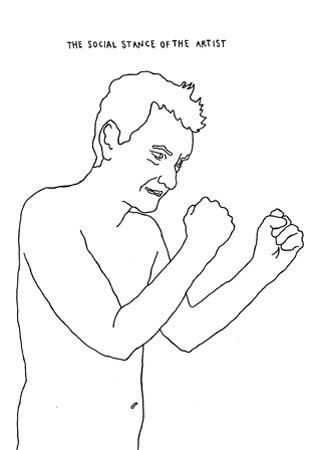

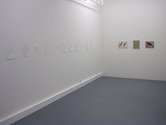


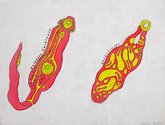
 Two Rooms presents a program of residencies and projects
Two Rooms presents a program of residencies and projects Advertising in this column
Advertising in this column
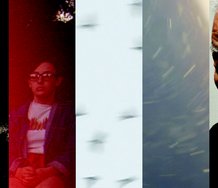
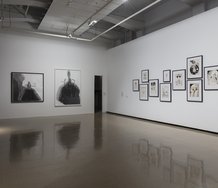
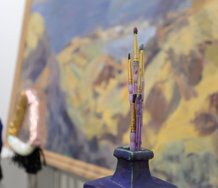
This Discussion has 0 comments.
Comment
Participate
Register to Participate.
Sign in
Sign in to an existing account.